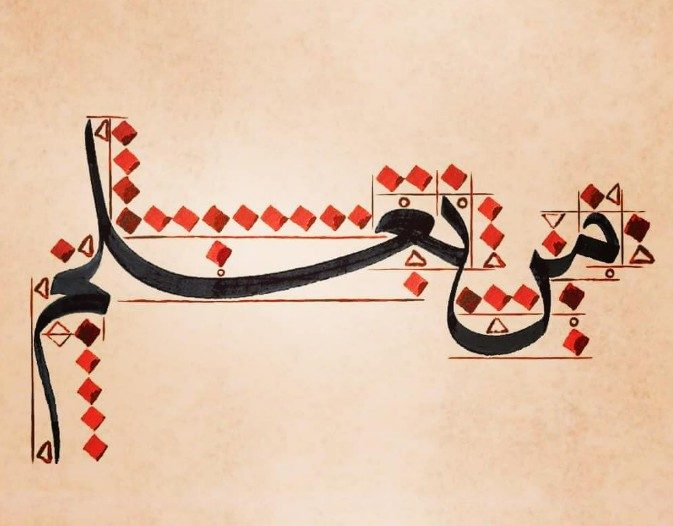
Reading Time: mins
The Golden Age of Islamic art and calligraphy is one of the most fascinating chapters in world art history. Spanning roughly from the 8th to the 14th century, this period witnessed an extraordinary flowering of creativity that combined beauty, faith, and intellect. From ornate mosques to manuscripts adorned with intricate lettering, Islamic art from this era continues to inspire artists, historians, and admirers across the globe.

The Golden Age of Islamic civilization was fueled by a combination of factors: political stability in major empires like the Abbasid Caliphate, flourishing trade routes that connected East and West, and a deep cultural emphasis on knowledge and learning. Major centers of scholarship such as Baghdad, Cairo, Córdoba, and Damascus became melting pots of ideas, where art, science, literature, and philosophy intertwined.
Within this environment, art was not created in isolation but was nurtured alongside advances in mathematics, astronomy, medicine, and architecture. It is this blending of intellectual and artistic pursuits that gave rise to works of stunning complexity and harmony.

Unlike in many other cultures where painting or sculpture held the highest prestige, in Islamic art calligraphy reigned supreme. The reason lies in the central role of the Qur’an. Since the Qur’an is considered the literal word of God in Islam, its written form was revered as sacred. Writing became more than a method of communication—it became an art form in itself.
Master calligraphers were highly respected, and their skills were passed down through rigorous training. Over time, distinct styles emerged, each suited for different purposes:




These scripts were not simply written—they were crafted with deliberate precision, balance, and rhythm, reflecting both artistic creativity and spiritual devotion.
Islamic art is also renowned for its geometric patterns and arabesques—repeating floral and vegetal motifs that seem infinite in their complexity. These designs often appeared alongside calligraphy, adorning mosques, palaces, manuscripts, textiles, and ceramics.

The use of geometry in Islamic art wasn’t only about aesthetics. It symbolized the infinite nature of God, unity within diversity, and the harmony of creation. Mathematicians and artists worked hand in hand, creating dazzling mosaics, tilework, and illuminated manuscripts that continue to awe viewers today.
The Dome of the Rock (Jerusalem, 7th century): One of the earliest and most iconic monuments of Islamic architecture, richly decorated with Kufic inscriptions and dazzling mosaics.

The Great Mosque of Córdoba (Spain): Famous for its horseshoe arches and breathtaking calligraphic inscriptions, this mosque represents the flowering of Islamic art in Andalusia.

The Blue Qur’an (9th–10th century, Tunisia): An extraordinary manuscript written in gold Kufic script on deep indigo-dyed parchment, showcasing the luxury and reverence given to Qur’anic texts.

The Alhambra (Granada, Spain): A masterpiece of Islamic architecture and design, its walls are covered with poetic inscriptions, arabesques, and geometric patterns.
Each of these sites and artifacts demonstrates the unity of calligraphy, geometry, and architecture in expressing both faith and artistry.
The Golden Age of Islamic art and calligraphy left an enduring influence not only on Islamic societies but also on global art. During the Crusades and through trade with Venice and the Silk Road, European artists encountered Islamic patterns, textiles, and manuscripts that later influenced the Renaissance.
Today, contemporary artists around the world—both within and outside the Muslim community—continue to draw inspiration from Islamic calligraphy and geometry. Modern murals, digital art, and even fashion often incorporate elements first developed centuries ago.

Studying the Golden Age of Islamic art and calligraphy reminds us of the power of creativity to transcend time, geography, and language. These works were not merely decorative—they were imbued with meaning, spirituality, and a deep respect for beauty and balance.
In an age where cultures are often divided, Islamic art stands as a testament to what can flourish when civilizations value knowledge, cross-cultural exchange, and artistic expression.

The Golden Age of Islamic art and calligraphy wasn’t just about beautiful objects—it was about connecting the human spirit to the divine through art. Every inscription, every pattern, and every building told a story of faith, intellect, and creativity. Whether you’re an art enthusiast, a history lover, or someone simply captivated by beauty, exploring this era opens a window into a world where art truly elevated the human experience.
Copyright © 2025. Artsy Blossom. All rights reserved.
Designed and Hosted by Sairi Digital Solutions